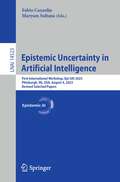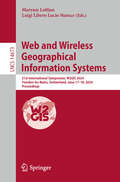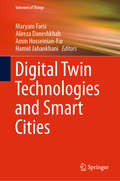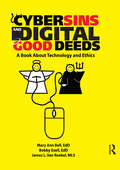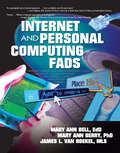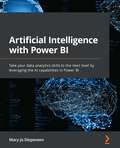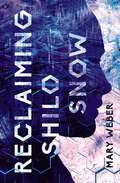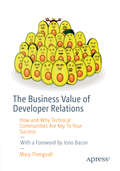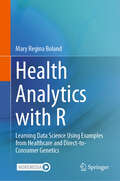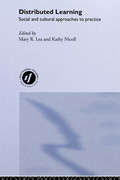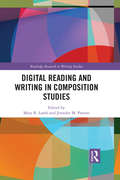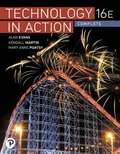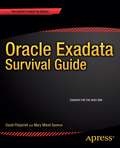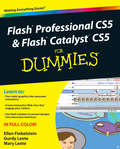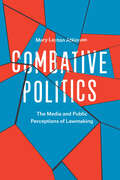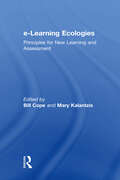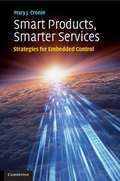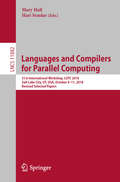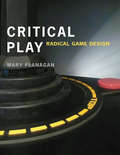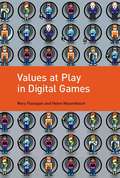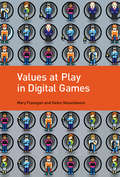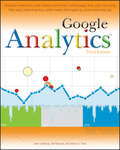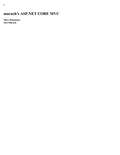- Table View
- List View
Epistemic Uncertainty in Artificial Intelligence: First International Workshop, Epi UAI 2023, Pittsburgh, PA, USA, August 4, 2023, Revised Selected Papers (Lecture Notes in Computer Science #14523)
by Fabio Cuzzolin Maryam SultanaThis LNCS 14523 conference volume constitutes the proceedings of the First International Workshop, Epi UAI 2023, in Pittsburgh, PA, USA, August 2023. The 8 full papers together included in this volume were carefully reviewed and selected from 16 submissions. Epistemic AI focuses, in particular, on some of the most important areas of machine learning: unsupervised learning, supervised learning, and reinforcement learning.
Web and Wireless Geographical Information Systems: 21st International Symposium, W2GIS 2024, Yverdon-les-Bains, Switzerland, June 17–18, 2024, Proceedings (Lecture Notes in Computer Science #14673)
by Maryam Lotfian Luigi Libero Lucio StaraceThis book constitutes the refereed proceedings of the 21st International Symposium on Web and Wireless Geographical Information Systems, W2GIS 2024, held in Yverdon-les-Bains, Switzerland, during June 18–19, 2024. The 8 full papers and 7 short papers included in this book were carefully reviewed and selected from 20 submissions. The book also contains one invited talk. They were organized in topical sections as follows: Spatiotemporal Data Analysis, Open Data and Reproducible Research, Geospatial Technologies and Tools, Advanced Computing and GIS Applications, Transportation Applications, and Doctoral Symposium.
Digital Twin Technologies and Smart Cities (Internet of Things)
by Hamid Jahankhani Amin Hosseinian-Far Maryam Farsi Alireza DaneshkhahThis book provides a holistic perspective on Digital Twin (DT) technologies, and presents cutting-edge research in the field. It assesses the opportunities that DT can offer for smart cities, and covers the requirements for ensuring secure, safe and sustainable smart cities. Further, the book demonstrates that DT and its benefits with regard to: data visualisation, real-time data analytics, and learning leading to improved confidence in decision making;reasoning, monitoring and warning to support accurate diagnostics and prognostics;acting using edge control and what-if analysis; andconnection with back-end business applications hold significant potential for applications in smart cities, by employing a wide range of sensory and data-acquisition systems in various parts of the urban infrastructure. The contributing authors reveal how and why DT technologies that are used for monitoring, visualising, diagnosing and predicting in real-time are vital to cities’ sustainability and efficiency. The concepts outlined in the book represents a city together with all of its infrastructure elements, which communicate with each other in a complex manner. Moreover, securing Internet of Things (IoT) which is one of the key enablers of DT’s is discussed in details and from various perspectives. The book offers an outstanding reference guide for practitioners and researchers in manufacturing, operations research and communications, who are considering digitising some of their assets and related services. It is also a valuable asset for graduate students and academics who are looking to identify research gaps and develop their own proposals for further research.
Cybersins and Digital Good Deeds: A Book About Technology and Ethics
by James Van Roekel MaryAnn Bell Bobby EzellThe A-to-Z source on cyberethics - the responsible use of technology!What is safe and responsible behavior for using the Internet? Cybersins and Digital Good Deeds: A Book About Technology and Ethics provides a comprehensive look at the innovative - and sometimes unscrupulous - world of rapidly evolving technology and the people who use it. This encyclopedic source helps even the most technology-challenged understand various facets relating to the use and misuse of technology in today’s society. Topics are organized A-to-Z for easy reference, with selections chosen because of historical importance, present relevance, and the likelihood of future impact. Privacy, security, censorship, and much, much more are discussed in detail to reveal the ethical complexities of each issue.Harmful and illegal cyber behavior can manifest quickly in several ways in today’s digital world. Keeping up with the shifts and advances in technology, its applications, and how it affects you can be difficult. Cybersins and Digital Good Deeds reviews the latest trends in computer technology and the impact it has on the way we live. This extensive book provides easy-to-understand explanations of tech terms, while clearly examining the current ethical issues surrounding different aspects of technology and its use in positive or destructive actions. Discussions include issues concerning general use, business, entertainment, multimedia development, and education.The broad range of ethical topics in Cybersins and Digital Good Deeds includes: advertising in school the Americans with Disabilities Act (ADA) and its impact upon technology in schools blogging and free speech bride scams video voyeurism censorship and filtering cheating in school using technology Child Online Protection Act Child Pornography Prevention Act (CPPA) computer addiction crackers, lamers, and phreaks cyberbullying cyberchondriacs disinhibition domain hijacking Online auction fraud elder care and technology Google Bombing identity theft pornography media and cognitive development movie duplication sharing audio files online gambling pyramid schemes the Patriot Act phishing podcasting Project Gutenberg RFID tracking spyware technolust Trojan horses and viruses much, much more! Cybersins and Digital Good Deeds is a perfect at-your-fingertips source for questions you may have on the jargon and the ethical use or misuse of technology. This book is perfect for business people; high school, public, and academic librarians; library science professors, education professors, students, or anyone needing clarification of issues related to technology and information ethics.
Internet and Personal Computing Fads
by Mary Berry James Van Roekel MaryAnn BellAn easy-to-understand guide to often-confusing computer/Internet jargon! Internet and Personal Computing Fads is an A-to-Z reference book written in a straightforward style that’s informative enough for library use but informal enough for general reading. This essential guide takes a practical look at the most often-seen computer and
Artificial Intelligence with Power BI: Take your data analytics skills to the next level by leveraging the AI capabilities in Power BI
by Mary-Jo DiepeveenLearn how to create your own AI model and consume it in your Power BI reports to gain better insights from your dataKey FeaturesLearn how to gain better insights from your data by applying different AI techniques within Power BISave time by creating machine learning models independently and integrating them within your BI reportsUnderstand how to combine Cognitive Services and Azure Machine Learning together with Power BIBook DescriptionThe artificial intelligence (AI) capabilities in Power BI enable organizations to quickly and easily gain more intelligent insights from unstructured and structured data.This book will teach you how to make use of the many AI features available today in Power BI to quickly and easily enrich your data and gain better insights into patterns that can be found in your data.You'll begin by understanding the benefits of AI and how it can be used in Power BI. Next, you'll focus on exploring and preparing your data for building AI projects and then progress to using prominent AI features already available in Power BI, such as forecasting, anomaly detection, and Q&A. Later chapters will show you how to apply text analytics and computer vision within Power BI reports. This will help you create your own Q&A functionality in Power BI, which allows you to ask FAQs from another knowledge base and then integrate it with PowerApps. Toward the concluding chapters, you'll be able to create and deploy AutoML models trained in Azure ML and consume them in Power Query Editor. After your models have been trained, you'll work through principles such as privacy, fairness, and transparency to use AI responsibly.By the end of this book, you'll have learned when and how to enrich your data with AI using the out-of-the-box AI capabilities in Power BI.What you will learnApply techniques to mitigate bias and handle outliers in your dataPrepare time series data for forecasting in Power BIPrepare and shape your data for anomaly detectionUse text analytics in Power Query EditorIntegrate QnA Maker with PowerApps and create an appTrain your own models and identify the best one with AutoMLIntegrate an Azure ML workspace with Power BI and use endpoints to generate predictionsWho this book is forThis artificial intelligence BI book is for data analysts and BI developers who want to explore advanced analytics or artificial intelligence possibilities with their data. Prior knowledge of Power BI will help you get the most out of this book.
Reclaiming Shilo Snow: The Pulse-Pounding Sequel to The Evaporation of Sofi Snow (Sofi Snow #2)
by Mary WeberShe was far more capable than Earth's leaders had accounted for, and they had no idea what she'd do next.“In this sequel to The Evaporation of Sofi Snow, Weber takes a darker tone, delving into alien abduction, experimentation on children, the machinations of power-hungry politicians, and black-market corruption . . . This is a well-paced page-turner.” —Kirkus ReviewsKnown as a brilliant mind that could hack her world’s darkest secrets, seventeen-year-old Sofi Snow is the most wanted teenager alive. She found her way to the icy, technologically brilliant planet of Delon to find Shilo, the brother everyone but Sofi believes is dead.But as she and Ambassador Miguel partner to find her brother and warn those on Earth of Delon’s dark designs on humanity, Sofi’s memories threaten to overtake her, distorting everything she holds true. She knows the Delonese once kept her in a dark, deceptive place . . . and destroyed a portion of her life. Now, the more they discover of Sofi’s past, the more Sofi feels herself unraveling—as each new revelation has her questioning the very existence of reality.In this harrowing sequel to The Evaporation of Sofi Snow, Sofi and Miguel must trust each other and discover the secrets locked inside Sofi’s mind as the line between what’s real and what they imagine begins to slip away . . . threatening to take the human race with it.
The Business Value of Developer Relations: How and Why Technical Communities Are Key To Your Success
by Mary ThengvallDiscover the true value of Developer Relations as you learn to build and maintain positive relationships with your developer community. Use the principles laid out in this book to walk through your company goals and discover how you can formulate a plan tailored to your specific needs.First you will understand the value of a technical community: why you need to foster a community and how to do it. Then you will learn how to be involved in community building on a daily basis: finding the right audience, walking the tightrope between representing the company and building a personal brand, in-person events, and more.Featuring interviews with Developer Relations professionals from many successful companies including Red Hat, Google, Chef, Docker, Mozilla, SparkPost, Heroku, Twilio, CoreOS, and more, and with a foreword by Jono Bacon, The Business Value of Developer Relations is the perfect book for anyone who is working in the tech industry and wants to understand where DevRel is now and how to get involved. Don’t get left behind – join the community today. What You’ll Learn Define community and sell community to your company Find, build, and engage with the community Determine how and when to hire community managersBuild your own personal brandWho This Book Is For Any business leaders/owners/stakeholders in the tech industry, tech evangelists, community managers or developer advocates.
Health Analytics with R: Learning Data Science Using Examples from Healthcare and Direct-to-Consumer Genetics
by Mary Regina BolandThis textbook teaches health analytics using examples from the statistical programming language R. It utilizes real-world examples with publicly available datasets from healthcare and direct-to-consumer genetics to provide learners with real-world examples and enable them to get their hands on actual data. This textbook is designed to accompany either a senior-level undergraduate course or a Masters level graduate course on health analytics. The reader will advance from no prior knowledge of R to being well versed in applications within R that apply to data science and health analytics. “I have never seen a book like this and think it will make an important contribution to the field. I really like that it covers environmental, social, and geospatial data. I also really like the coverage of ethics. These aspects of health analytics are often overlooked or deemphasized. I will definitely buy copies for my team.” - Jason Moore, Cedars-Sinai Medical Center “Overall, I have a highly positive impression of the book. It is VERY comprehensive. It covers very extensive data types. I do not recall other books with the same level of comprehensiveness.” - Shuangge Ma, Yale University “The book is comprehensive in both aspects of genetics, and health analytics. It covers any type of information a healthcare data scientist should be familiar with, whether they are novice or experienced. I found any chapter that I looked into comprehensive, but also not too detailed (although in general this book is more than 600 pages of comprehensive and detailed relevant information).” - Robert Moskovtich, Ben-Gurion University of the Negev
Distributed Learning: Social and Cultural Approaches to Practice
by Mary R. Lea Kathy NicollAt a time of increasing globalisation, the concept of open and distance learning is being constantly redefined. New technologies have opened up new ways of understanding and participating in Learning. Distributed Learning offers a collection of perspectives from a social and cultural practice-based viewpoint, with contributions from leading international authors in the field. Key issues in this comprehensive text are:*the challenges of ICT to traditional teaching and learning practices*the value and relevance of 'activity theory' and 'communities of practice' in educational institutions and the workplace*perspectives on the relationship between globalisation and distributed learning, and the breakdown of distinctions between global and local contexts*issues of identity and community in designing courses for the virtual student*language and literacies in distributed learning contextsThis book provides useful introductory reading, building a sound theoretical framework for practitioners interested in how distributed learning is shaping post-compulsory education.
Digital Reading and Writing in Composition Studies (Routledge Research in Writing Studies)
by Mary R. Lamb Jennifer M. ParrottAs digital reading has become more productive and active, the lines between reading and writing become more blurred. This book offers both an exploration of collaborative reading and pedagogical strategies for teaching reading and writing that reflect the realities of digital literacies. This edited scholarly collection offers strategies for teaching reading and writing that highlight the possibilities, opportunities, and complexities of digital literacies. Part 1 explores reading and writing that happen digitally and offers frameworks for thinking about this process. Part 2 focuses on strategies for the classroom by applying reading theories, design principles, and rhetorical concepts to instruction. Part 3 introduces various disciplinary implications for this blended approach to writing instruction. What is emerging is new theories and practices of reading in both print and digital spaces—theories that account for how diverse student readers encounter and engage digital texts. This collection contributes to this work by offering strategies for sustaining reading and cultivating writing in this landscape of changing digital literacies. The book is essential for the professional development of beginning teachers, who will appreciate the historical and bibliographic overview as well as classroom strategies, and for busy veteran teachers, who will gain updated knowledge and a renewed commitment to teaching an array of literacy skills. It will be ideal for graduate seminars in composition theory and pedagogy, both undergraduate and graduate; and teacher education courses, and will be key reading for scholars in rhetoric and composition interested in composition history, assessment, communication studies, and literature pedagogy.
Technology In Action Complete
by Alan Evans Kendall Martin Mary PoatsyTechnology in Action Complete uses practical content and hands-¿on projects to engage students in computing tasks and skills they can apply at work, in class, or at home. Designed for today's technically savvy students, the text introduces difficult concepts at a basic level early on, then expands upon these skills as students build mastery. The 16th edition further emphasizes the importance of digital literacy with two new Try This projects
Oracle Exadata Survival Guide
by David Fitzjarrell Mary Mikell SpenceOracle Exadata Survival Guide is a hands-on guide for busy Oracle database administrators who are migrating their skill sets to Oracle's Exadata database appliance. The book covers the concepts behind Exadata, and the available configurations for features such as smart scans, storage indexes, Smart Flash Cache, hybrid columnar compression, and more. You'll learn about performance metrics and execution plans, and how to optimize SQL running in Oracle's powerful, new environment. The authors also cover migration from other servers. Oracle Exadata is fast becoming the standard for large installations such as those running data warehouse, business intelligence, and large-scale OLTP systems. Exadata is like no other platform, and is new ground even for experienced Oracle database administrators. The Oracle Exadata Survival Guide helps you navigate the ins and outs of this new platform, de-mystifying this amazing appliance and its exceptional performance. The book takes a highly practical approach, not diving too deeply into the details, but giving you just the right depth of information to quickly transfer your skills to Oracle's important new platform. Helps transfer your skills to the platform of the future Covers the important ground without going too deep Takes a practical and hands-on approach to everyday tasks
Flash Professional CS5 & Flash Catalyst CS5 For Dummies
by Ellen Finkelstein Gurdy Leete Mary LeeteA full-color guide for getting rewarding results with Flash CS5!Flash is used in the creation of web animation, games, media rich websites, presentations, and more. Adobe's Flash CS5 product has been divided into three separate products custom-tailored for different audiences, and this book covers the Professional product; the traditional animation/media serving tool; and Catalyst, the web/interface design tool. This book provides a fun and friendly full-color guide to Flash and all it can do to add some flair to your site.Walks you through both Professional and Catalyst as well as the traditional Flash animation toolOffers guidance for getting acquainted with the interface; creating images, objects, text, and layers for animation; and working with symbols and buttonsIntroduces using Flash for online publishing and mobile designsAddresses how to turn existing images into interactive sites or interfaces with CatalystOffers helpful tips on troubleshooting and best practices for creating interactive websitesUsing the knowledge you gain from Flash CS5 Professional & Flash CS5 Catalyst For Dummies, you'll quickly prove that you are not a flash in the pan!
Combative Politics: The Media and Public Perceptions of Lawmaking
by Mary Layton AtkinsonFrom the Affordable Care Act to No Child Left Behind, politicians often face a puzzling problem: although most Americans support the aims and key provisions of these policies, they oppose the bills themselves. How can this be? Why does the American public so often reject policies that seem to offer them exactly what they want? By the time a bill is pushed through Congress or ultimately defeated, we’ve often been exposed to weeks, months—even years—of media coverage that underscores the unpopular process of policymaking, and Mary Layton Atkinson argues that this leads us to reject the bill itself. Contrary to many Americans’ understandings of the policymaking process, the best answer to a complex problem is rarely self-evident, and politicians must weigh many potential options, each with merits and drawbacks. As the public awaits a resolution, the news media tend to focus not on the substance of the debate but on descriptions of partisan combat. This coverage leads the public to believe everyone in Washington has lost sight of the problem altogether and is merely pursuing policies designed for individual political gain. Politicians in turn exacerbate the problem when they focus their objections to proposed policies on the lawmaking process, claiming, for example, that a bill is being pushed through Congress with maneuvers designed to limit minority party input. These negative portrayals become linked in many people’s minds with the policy itself, leading to backlash against bills that may otherwise be seen as widely beneficial. Atkinson argues that journalists and educators can make changes to help inoculate Americans against the idea that debate always signifies dysfunction in the government. Journalists should strive to better connect information about policy provisions to the problems they are designed to ameliorate. Educators should stress that although debate sometimes serves political interests, it also offers citizens a window onto the lawmaking process that can help them evaluate the work their government is doing.
e-Learning Ecologies: Principles for New Learning and Assessment
by Bill Cope Mary Kalantzise-Learning Ecologies explores transformations in the patterns of pedagogy that accompany e-learning—the use of computing devices that mediate or supplement the relationships between learners and teachers—to present and assess learnable content, to provide spaces where students do their work, and to mediate peer-to-peer interactions. Written by the members of the "new learning" research group, this textbook suggests that e-learning ecologies may play a key part in shifting the systems of modern education, even as technology itself is pedagogically neutral. The chapters in this book aim to create an analytical framework with which to differentiate those aspects of educational technology that reproduce old pedagogical relations from those that are genuinely innovative and generative of new kinds of learning. Featuring case studies from elementary schools, colleges, and universities on the practicalities of new learning environments, e-Learning Ecologies elucidates the role of new technologies of knowledge representation and communication in bringing about change to educational institutions.
Smart Products, Smarter Services: Strategies for Embedded Control
by Mary J. CroninWe are surrounded by products that have minds of their own. Computing power, in the form of microcontrollers, microprocessors, sensors, and data storage chips, has become so cheap that manufacturers are building connectivity and embedded intelligence into all types of consumer goods. These 'smart products' are fundamentally changing both the competitive landscape for business and the daily lives of consumers. This book analyzes the evolution of smart products to help managers understand the impact of embedded product intelligence on corporate strategy, consumer value, and industry competition. It describes four different ecosystem strategies for designing and launching smart products: the control-focused Hegemon, the standards-focused Federator, the high growth and brand-focused Charismatic Leader, and the disruptive industry Transformer. This ecosystem model is then applied to smart products in the automotive, wireless, energy, residential, and health industries. The book concludes with recommendations for successfully managing smart products and services.
Languages and Compilers for Parallel Computing: 31st International Workshop, LCPC 2018, Salt Lake City, UT, USA, October 9–11, 2018, Revised Selected Papers (Lecture Notes in Computer Science #11882)
by Mary Hall Hari SundarThis book constitutes the thoroughly refereed post-conference proceedings of the 31st International Workshop on Languages and Compilers for Parallel Computing, LCPC 2018, held in Salt Lake City, UT, USA, in October 2018. The 14 revised full papers were carefully reviewed and selected from 26 submissions. Specific topics are compiling for parallelism and parallel compilers, static, dynamic, and adaptive optimization of parallel programs, parallel programming models and languages, formal analysis and verification of parallel programs, parallel runtime systems and libraries, performance analysis and debugging tools for concurrency and parallelism, parallel algorithms and concurrent data structures, parallel applications, synchronization and concurrency control, software engineering for parallel programs, fault tolerance for parallel systems, and parallel programming and compiling for heterogeneous systems.
Critical Play: Radical Game Design
by Mary FlanaganAn examination of subversive games—games designed for political, aesthetic, and social critique.For many players, games are entertainment, diversion, relaxation, fantasy. But what if certain games were something more than this, providing not only outlets for entertainment but a means for creative expression, instruments for conceptual thinking, or tools for social change? In Critical Play, artist and game designer Mary Flanagan examines alternative games—games that challenge the accepted norms embedded within the gaming industry—and argues that games designed by artists and activists are reshaping everyday game culture. Flanagan provides a lively historical context for critical play through twentieth-century art movements, connecting subversive game design to subversive art: her examples of “playing house” include Dadaist puppet shows and The Sims. She looks at artists' alternative computer-based games and explores games for change, considering the way activist concerns—including worldwide poverty and AIDS—can be incorporated into game design.Arguing that this kind of conscious practice—which now constitutes the avant-garde of the computer game medium—can inspire new working methods for designers, Flanagan offers a model for designing that will encourage the subversion of popular gaming tropes through new styles of game making, and proposes a theory of alternate game design that focuses on the reworking of contemporary popular game practices.
Values at Play in Digital Games
by Mary Flanagan Helen NissenbaumAll games express and embody human values, providing a compelling arena in which we play out beliefs and ideas. "Big ideas" such as justice, equity, honesty, and cooperation -- as well as other kinds of ideas, including violence, exploitation, and greed -- may emerge in games whether designers intend them or not. In this book, Mary Flanagan and Helen Nissenbaum present Values at Play, a theoretical and practical framework for identifying socially recognized moral and political values in digital games. Values at Play can also serve as a guide to designers who seek to implement values in the conception and design of their games. After developing a theoretical foundation for their proposal, Flanagan and Nissenbaum provide detailed examinations of selected games, demonstrating the many ways in which values are embedded in them. They introduce the Values at Play heuristic, a systematic approach for incorporating values into the game design process. Interspersed among the book's chapters are texts by designers who have put Values at Play into practice by accepting values as a design constraint like any other, offering a real-world perspective on the design challenges involved.
Values at Play in Digital Games (The\mit Press Ser.)
by Mary Flanagan Helen NissenbaumA theoretical and practical guide to integrating human values into the conception and design of digital games.All games express and embody human values, providing a compelling arena in which we play out beliefs and ideas. “Big ideas” such as justice, equity, honesty, and cooperation—as well as other kinds of ideas, including violence, exploitation, and greed—may emerge in games whether designers intend them or not. In this book, Mary Flanagan and Helen Nissenbaum present Values at Play, a theoretical and practical framework for identifying socially recognized moral and political values in digital games. Values at Play can also serve as a guide to designers who seek to implement values in the conception and design of their games. After developing a theoretical foundation for their proposal, Flanagan and Nissenbaum provide detailed examinations of selected games, demonstrating the many ways in which values are embedded in them. They introduce the Values at Play heuristic, a systematic approach for incorporating values into the game design process. Interspersed among the book's chapters are texts by designers who have put Values at Play into practice by accepting values as a design constraint like any other, offering a real-world perspective on the design challenges involved.
Google Analytics, 3rd Edition
by Joe Teixeira Jerri Ledford Mary E. TylerGet the most out of the free Google Analytics service-and get more customers Google Analytics allows you to discover vital information about how end users interact with their Web sites by collecting vital data and providing tools to analyze it, with the intention of improving the end-user experience and, ultimately converting users into customers. This indispensible guide delves into the latest updates to the newest version of Google Analytics-3. 0-and explains the concepts behind this amazing free tool. You'll discover what information to track, how to choose the right goals and filters, techniques for reading Google Analytics reports and graphs, and, most importantly, how to compile this data and use it to improve your Web site and attract more potential customers. Takes an in-depth look at Google Analytics 3. 0 and walks you through the possibilities it offers Explains how to read Google Analytics reports and graphs so that you can compile this data and use it to improve your Web site and attract more users Shares techniques for converting end users into customers Features tips and suggestions for getting the information you need from Google Analytics reports and then converting that information into actionable tasks you can use With Google Analytics, Third Edition, you&'ll be well on your way to retrieving the information you need to convert visitors to your site into customers! Note: CD-ROM/DVD and other supplementary materials are not included as part of eBook file.
Scandal and Democracy: Media Politics in Indonesia
by Mary E. McCoySuccessful transitions to enduring democracy are both difficult and rare. In Scandal and Democracy, Mary E. McCoy explores how newly democratizing nations can avoid reverting to authoritarian solutions in response to the daunting problems brought about by sudden change. The troubled transitions that have derailed democratization in nations worldwide make this problem a major concern for scholars and citizens alike.This study of Indonesia's transition from authoritarian rule sheds light on the fragility not just of democratic transitions but of democracy itself and finds that democratization's durability depends, to a surprising extent, on the role of the media, particularly its airing of political scandal and intraelite conflict. More broadly, Scandal and Democracy examines how the media's use of new freedoms can help ward off a slide into pseudodemocracy or a return to authoritarian rule. As Indonesia marks the twentieth anniversary of its democratic revolution of 1998, it remains among the world's most resilient new democracies and one of the few successful democratic transitions in the Muslim world. McCoy explains the media's central role in this change and corroborates that finding with comparative cases from Mexico, Tunisia, and South Korea, offering counterintuitive insights that help make sense of the success and failure of recent transitions to democracy.
ASP. NET Core MVC: Training and Reference
by Joel Murach Mary DelamaterIf you know the basics of C#, you're ready to learn how to create web applications using Microsoft's powerful technology, ASP.NET Core MVC (Model-View-Controller). And there's no more practical way to do it than with this book. <p><p> By the end of section 1...just 5 chapters...you'll be developing real-world web apps using C# code for the model and controller classes...HTML, CSS, and Razor code for the view files (for the user interface)...and Bootstrap classes for responsive design so that your apps adapt well to all screen sizes. You'll also be able use the debugging tools in Visual Studio and your browser to test your apps and make sure they'll work right for all users. <p><p> In section 2, you'll build out that set of skills to create more complex controllers, work with Razor views, handle cookies and sessions, do model binding, validate data, and handle database data with EF (Entity Framework) Core. You'll also see how all these skills come together in a single application, with coverage of the gotchas that can occur and how to solve them. <p><p> Finally, in section 3, you can pick up additional skills as you need them to: create custom tag helpers and view components; authenticate and authorize users; use dependency injection to automate testing; and use Visual Studio Code. <p><p> All along the way, you'll get complete web apps that show you how each feature works in context (you can download these for free from the Murach website). You'll get chapter exercises that let you practice your new skills. And you'll get Murach's distinctive paired-pages format that presents each skill in a 2-page spread, full of examples, notes, and explanation...a format that developers praise because it saves them both training and reference time.
Moodle 1.9 for Teaching 7-14 Year Olds: Beginner's Guide
by Mary CoochThis book is part of Packt's Beginner's Guide series. Written in a friendly tone, the book starts at the very beginning with a blank Moodle page and you are taken step by step through the most useful features of Moodle, helped with many illustrative screenshots. The chapters gradually build up your skills and by the end of the book you will be confident enough to design a fully functional, interactive course for 7-14 year olds. This book is for regular, non-technical teachers of pre-teen or early teenage children. It assumes no prior knowledge of Moodle and no particular expertise on the Web. Classroom assistants may also find this book a very useful resource.
